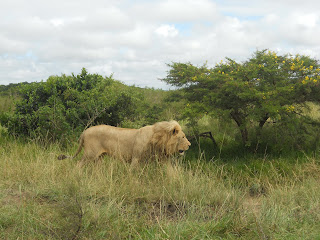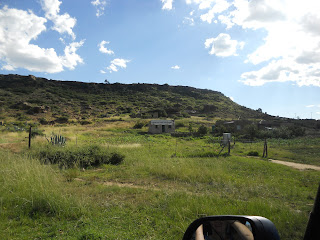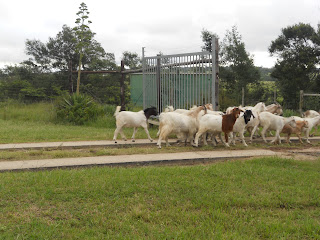After creating a sand box for the pre-school, (crèche) I went on a mini (one day) safari. There are 299 mammal species in South Africa, of which 2 are critically endangered, 11 are endangered, 15 are vulnerable, and 13 are near-threatened. Now, I did not see anywhere close to these numbers, however, I did learn quite a bit about plant and animal life in the eastern cape of South Africa. For instance, I have been admiring all the lantanas growing in the wild. Potted plants I love to grow on the deck, however Seattle is just too cool and cloudy even in the summer. And I have been spotting all the guava trees. The kids pick the fruit off the trees here and eat them when they are the size of a dime. I can’t imagine how bitter that must taste. Anyway both of these plants were introduced to here from South America, and because of birds spreading the seed they are considered a weed here, and soon to be noxious.
I saw the plant where camphor comes from, and it is related to cinnamon. One of the oldest uses of camphor in its natural state was as a preservative for embalming the dead. During the era of the Black Plague in Europe, a lump of camphor worn around the neck was said to ward off disease, which was probably a myth. Camphor oil is frequently an ingredient in pain-numbing rubs or ointments. It helps pain from arthritis, muscle aches and bruising. It also can be used as a stimulant rub, encouraging circulation in stiff or cold limbs. Internally, camphor is a reliable remedy for sinus or lung congestion, and acts as an expectorant when steam with camphor is breathed in. It also can help to reduce fever as an inhalant. Camphor oil is a key ingredient in antibacterial and astringent cosmetic washes, to reduce acne or oily skin. It also is found in a processed white crystalline form, in which it can be used as a soap-making ingredient, as an insect repellent around the house and as a preservative. Cabinets made from the wood of camphor are popular for natural history collections, as they keep away moths, worms and other insects. In Japan and China, it was used as a varnish, as a paint remover for oil paints, as fragrant oil for burning.
The kind of camphor used in cooking is not the kind used medicinally or around the house. Only camphor labeled edible should be used in cookery. It was a popular ingredient in candies in medieval Europe in its edible form, and still is used in sweet dishes in Indian cooking. It flavored some of the earliest ice cream made in eastern Asia. It is mainly used in traditional Indian recipes now, and is sometimes called raw camphor or green camphor.
Camphor is a strong substance, similar to turpentine, and can be irritating to some people's skin, eyes or nasal tissues. It should be used with care. It is also sold as a burnable resin for use in Hindu religious ceremonies celebrating Shiva.
I know that was way more than you all wanted to know about one plant, just letting you in on some of the safari details. So, on with the animals which you will probably find more interesting. I will simply list the animals I saw and give just a little info about each. Special thanks go to Cindy Sattler for inserting the pictures in these blogs.
The Blue Wildebeest or Brindled Gnu can reach almost 5 feet high and weigh 500 – 600 lbs. They mingle well with Zebras, giraffes, and impalas. Bulls area territorial, so there can also bachelor herds. They are easily scared so picture is a little blurry. This animal can achieve speeds of 50 mph.
In the antelope family I saw four different species. The impala, known locally as the MacDonald’s M because on the butt, the black stripes form a letter M with the tail. They are 90 to 120 lbs depending on gender. A ram has a rather large harem, so impalas also have bachelor herds. The lambs are kept together in crèches with mama’s taking turns providing child care. These animals can jump 10 feet high and 12 feet in distance.
The Kudu is a larger animal in the antelope family. In this species only the male has horns and depending on gender weigh 330 – 600 lbs. The kudu stay in small clusters 3 – 10. Unlike most other antelope, this one stays hidden in the undergrowth of trees, and it has long hair, and a bushy, almost fox like tail. I don’t know if you can see it in the picture, is has two horizontal stripes underneath the eyes down towards the nose. Its hide is also striped to help it blend in to its surroundings.
 The last animal in the antelope family I saw was the Blesbok. Both sexes have horns and weigh between 125 – 160 lbs. This animal has a delightful wide white stripe down the center of its face. Unfortunately the picture probably doesn’t allow you to see this. This species also runs in large herds. For many centuries these four species of grass feed animals have been providing much meat and adding protein to the diet. Most of these in the antelope family can travel at a speed of 61 mph if needed.
The last animal in the antelope family I saw was the Blesbok. Both sexes have horns and weigh between 125 – 160 lbs. This animal has a delightful wide white stripe down the center of its face. Unfortunately the picture probably doesn’t allow you to see this. This species also runs in large herds. For many centuries these four species of grass feed animals have been providing much meat and adding protein to the diet. Most of these in the antelope family can travel at a speed of 61 mph if needed.
The next three pictures were of my favorite group of the day, the lions. A couple of females had cubs and they were adorable. We drove right into the midst of them. They were literally 15 – 20 feet from us. The dominate male of this pride is a white lion, and there were other males hanging around. Lions weigh between 330 and 525 lbs. Lions are only found in protected areas of South Africa. There numbers have been greatly compromised. Lions travel at a speed of 50 mph.
There are only 20,000 great white rhinos left in the world. I have been told that so far this year, close to 700 rhinos have been killed for their horns. Poachers tranquilize them, then cut clear into the skull to get all the horn, thus the animal bleeds to death. There are endangered. This male rhino probably weighs a little over three tons. We drove right up within 10 feet of him and watched him very casually graze the lush grass. Rhinos can live up to 50 years, and their gestation period is 16 months. The cow and calf were hidden somewhere and would not come out. It is estimated that the rhino is from the Miocene era, having been around for some 5 – 23 million years.
 This Ostrich was so intrigued by the blanket I was sitting on. Ostriches have brains that are smaller in size than their eyeballs. Males are black and females grey. They can run up to 40 mph. They are also from the Miocene period. Their feet with two toes and very large toe nails almost look dinosaur-ish.
This Ostrich was so intrigued by the blanket I was sitting on. Ostriches have brains that are smaller in size than their eyeballs. Males are black and females grey. They can run up to 40 mph. They are also from the Miocene period. Their feet with two toes and very large toe nails almost look dinosaur-ish.
The zebras were fascinating. No two zebras have the same striped pattern. They tend to stay in smaller family type groupings, unless seasonally travelling to new grazing regions. Zebras weigh between 600 and 750 lbs. Gestation period is 12 months. New born zebras almost have their adult length in legs. This allows a new born to hide completely behind its mother. Zebras can run up to 40 mph.
The only cheetahs at this game reserve were three kittens whose mother died at three weeks. These cheetahs are now five years old and completely domesticated. Cheetahs can live up to 12 years. They are 75 to 135 lbs and they can travel up to 70 mph. You should see the claws and teeth on these. Cheetahs are only found in protected areas of South Africa.
My last slide for this blog is of the Giraffe, one of my favorite animals. Depending on gender can weigh between 1500 and 3000 lbs, and range between 14 – 17 feet in height. They can live up to 28 years and the gestation period is 15 months. They can run at a speed of 32 mph. They are only in protected areas in South Africa.
Well I hope you enjoyed our little safari. Your legs, knees and back are probably feeling less jostled than mine after a day of four wheeling it over hill and dale. Catch you later this week.

































